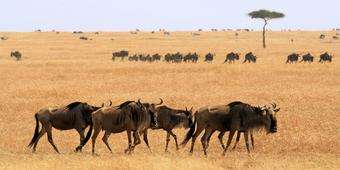Grasses, mammals, and their co-evolution

After millions of years of amphibians, dinosaurs, and early mammals ruling the forests and swamps of the hot, humid Mesozoic and early Cenozoic, a new habitat emerged. Small patches of grasslands sprang up and spread as the climate cooled and dried. These new, grassy expanses brought advantages and challenges.
Prey species were safer in groups than on their own, for example, as a herd of grazers needs only one or two members to keep watch for predators while others ate or rested. Grass's scant nutrition meant grazing herd animals had to eat often and travel great distances in their incessant quest for sustenance. The savannah was both easy to move through and tough for predators to surprise prey in.
Many mammalian groups were shaped by these features – like the knee-high, multi-toed herbivore that evolved into today's horse. But how, exactly, did these changes happen? And how did the varying evolutionary pressures influence each other?
"These questions have ignited much interest in paleontological and modern ecological research," says SFI Omidyar Fellow Justin Yeakel, who is co-organizing with Dartmouth's Nathaniel Dominy this week's SFI working group, Coupled Grassland and Mammalian Community Dynamics over Ecological and Evolutionary Timescales.
At the two-day meeting, experts in community dynamics, evolution, morphology, anthropology, and climatology are exploring how grassy plants expanded from isolated patches to dominate the landscape, how they affected mammalian evolution, and how, in turn, mammalian diversification influenced grasslands.
The ecologies of interest were continually in flux, adding special complexity. "I'm interested in how mammalian species might develop grassland-specific traits in ecosystems that are constantly shifting," says Yeakel.
The working group will identify the most relevant and tractable questions and create smaller groups for specific research projects. A subsequent meeting at Dartmouth will analyze and integrate the projects' results.
Provided by Santa Fe Institute




















